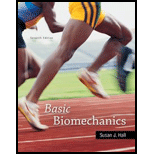
Basic Biomechanics
7th Edition
ISBN: 9780073522760
Author: Susan J Hall
Publisher: McGraw-Hill Education
expand_more
expand_more
format_list_bulleted
Concept explainers
Question
Chapter 13, Problem 6IP
Summary Introduction
To explain: The lever classes for a golf club, a swinging door and a broom.
Concept introduction: A rigid bar which can be rotated about an axis due to a force which can move a resistance is known as lever. The liver can be classified as first-class lever, second class lever, and third-class lever.
Expert Solution & Answer
Want to see the full answer?
Check out a sample textbook solution
Chapter 13 Solutions
Basic Biomechanics
Ch. 13 - Why does a force directed through an axis of...Ch. 13 - Why does the orientation of a force acting on a...Ch. 13 - A 23-kg boy sits 1.5 m from the axis of rotation...Ch. 13 - Prob. 4IPCh. 13 - Two people push on opposite sides of a swinging...Ch. 13 - Prob. 6IPCh. 13 - Prob. 7IPCh. 13 - Prob. 8IPCh. 13 - A 10-kg block sits motionless on a table in spite...Ch. 13 - Prob. 10IP
Ch. 13 - A 35-N hand and forearm are held at a 45 angle to...Ch. 13 - A hand exerts a force of 90 N on a scale at 32 cm...Ch. 13 - A patient rehabilitating a knee injury performs...Ch. 13 - A worker leans over and picks up a 90-N box at a...Ch. 13 - A man carries a 3 m, 32-N board over his shoulder....Ch. 13 - A therapist applies a lateral force of 80 N to the...Ch. 13 - Tendon forces Ta and Tb are exerted on the...
Knowledge Booster
Learn more about
Need a deep-dive on the concept behind this application? Look no further. Learn more about this topic, bioengineering and related others by exploring similar questions and additional content below.Similar questions
- In a general sense, how do skeletal muscles produce movement?arrow_forwardBriefly define the types of joint movements available at a ball-and-socket joint.arrow_forwardWhat is a motor unit? Why does a rapid series of muscle twitches yield a stronger overall contraction than a single twitch?arrow_forward
- Movement at the shoulder joint that moves the upper limb laterally away from the body is called ________. elevation eversion abduction lateral rotationarrow_forwardFigure 38.37 Which of the following statements about muscle contraction is true? The power stroke occurs when ATP is hydrolyzed to ADP and phosphate. The power stroke occurs when ADP and phosphate dissociate from the myosin head. The power stroke occurs when ADP and phosphate dissociate from the actin active site. The power stroke occurs when Ca2+ binds the calcium head.arrow_forwardWatch this video (http://openstaxcollege.org/l/anatomical) to learn about anatomical motions. What motions involve increasing or decreasing the angle of the foot at the ankle?arrow_forward
- You are training athletes for the 100-meter dash. They need muscles specialized for speed and strength, not endurance. What muscle characteristics would your training regimen aim to develop? How would you alter it to train a long-distance swimmer?arrow_forwardHow do actin and myosin interact in a sarcomere to bring about muscle contraction? What roles do ATP and calcium play?arrow_forwardWatch this video (http://openstaxcollege.org/l/flexext) to learn more about the flexion and extension of the knee, as the femur both rolls and glides on the tibia to maintain stable contact between the bones in all knee positions. The patella glides along a groove on the anterior side of the distal femur. The collateral ligaments on the sides of the knee become tight in the fully extended position to help stabilize the knee. The posterior cruciate ligament supports the knee when flexed and the anterior cruciate ligament becomes tight when the knee comes into full extension to resist hyperextension. What are the ligaments that support the knee joint?arrow_forward
- A muscle that has a pattern of fascicles running along the long axis of the muscle has which of the following fascicle arrangements? circular pennate parallel rectusarrow_forwardThe large muscle group that attaches the leg to the pelvic girdle and produces extension of the hip joint is the ________ group. gluteal obturator adductor abductorarrow_forwardWhich muscle pair plays a role in respiration? intertransversarii, interspinales semispinalis cervicis, semispinalis thoracis trapezius, rhomboids diaphragm, scalenearrow_forward
arrow_back_ios
SEE MORE QUESTIONS
arrow_forward_ios
Recommended textbooks for you
 Human Physiology: From Cells to Systems (MindTap ...BiologyISBN:9781285866932Author:Lauralee SherwoodPublisher:Cengage Learning
Human Physiology: From Cells to Systems (MindTap ...BiologyISBN:9781285866932Author:Lauralee SherwoodPublisher:Cengage Learning Principles Of Radiographic Imaging: An Art And A ...Health & NutritionISBN:9781337711067Author:Richard R. Carlton, Arlene M. Adler, Vesna BalacPublisher:Cengage LearningLifetime Physical Fitness & WellnessHealth & NutritionISBN:9781337677509Author:HOEGERPublisher:Cengage
Principles Of Radiographic Imaging: An Art And A ...Health & NutritionISBN:9781337711067Author:Richard R. Carlton, Arlene M. Adler, Vesna BalacPublisher:Cengage LearningLifetime Physical Fitness & WellnessHealth & NutritionISBN:9781337677509Author:HOEGERPublisher:Cengage Human Biology (MindTap Course List)BiologyISBN:9781305112100Author:Cecie Starr, Beverly McMillanPublisher:Cengage Learning
Human Biology (MindTap Course List)BiologyISBN:9781305112100Author:Cecie Starr, Beverly McMillanPublisher:Cengage Learning Anatomy & PhysiologyBiologyISBN:9781938168130Author:Kelly A. Young, James A. Wise, Peter DeSaix, Dean H. Kruse, Brandon Poe, Eddie Johnson, Jody E. Johnson, Oksana Korol, J. Gordon Betts, Mark WomblePublisher:OpenStax College
Anatomy & PhysiologyBiologyISBN:9781938168130Author:Kelly A. Young, James A. Wise, Peter DeSaix, Dean H. Kruse, Brandon Poe, Eddie Johnson, Jody E. Johnson, Oksana Korol, J. Gordon Betts, Mark WomblePublisher:OpenStax College

Human Physiology: From Cells to Systems (MindTap ...
Biology
ISBN:9781285866932
Author:Lauralee Sherwood
Publisher:Cengage Learning

Principles Of Radiographic Imaging: An Art And A ...
Health & Nutrition
ISBN:9781337711067
Author:Richard R. Carlton, Arlene M. Adler, Vesna Balac
Publisher:Cengage Learning

Lifetime Physical Fitness & Wellness
Health & Nutrition
ISBN:9781337677509
Author:HOEGER
Publisher:Cengage


Human Biology (MindTap Course List)
Biology
ISBN:9781305112100
Author:Cecie Starr, Beverly McMillan
Publisher:Cengage Learning

Anatomy & Physiology
Biology
ISBN:9781938168130
Author:Kelly A. Young, James A. Wise, Peter DeSaix, Dean H. Kruse, Brandon Poe, Eddie Johnson, Jody E. Johnson, Oksana Korol, J. Gordon Betts, Mark Womble
Publisher:OpenStax College